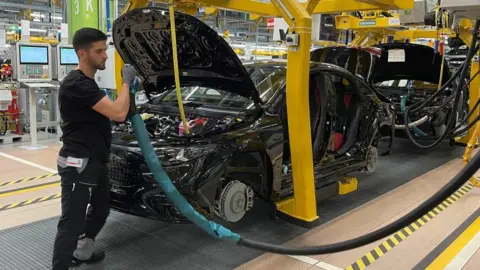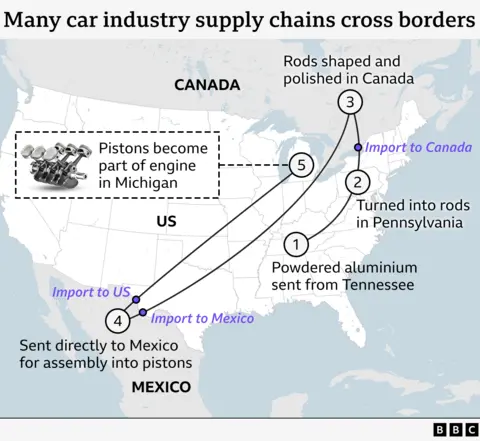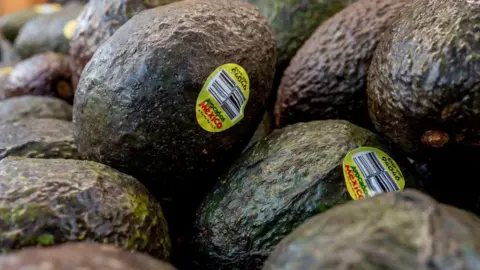Business reporters, BBC News
 Reuters
ReutersThe United States and the European Union have reached a trade agreement which imposes a blanket tariff of 15% on almost all EU goods imported into the US.
The agreement is half the 30% tariff originally threatened by US President Donald Trump, which was due to be imposed on 1 August, and includes exemptions on some goods, including semiconductor equipment, some agricultural products and certain raw materials.
EU Commission President Ursula von der Leyen has called it the “biggest trade deal ever” – but admitted that many details “have to be sorted out”.
“That will happen over the next number of weeks,” she said.
It’s the latest in a flurry of trade deals made by Trump since coming to office, which he says will generate billions in tax revenue and encourage firms to do business in the US to avoid the taxes.
However, economists have warned these levies – and those introduced in response by other countries – could push prices up for American consumers.
That’s because tariffs are paid by the domestic company importing the goods, which may choose to pass the cost on to customers, or to reduce imports, meaning fewer products are available.
So which things could become more expensive?
Cars
The US imported about eight million cars last year – accounting for about $240bn (£186bn) in trade.
In April, buying a European car became a lot more expensive for US consumers after Trump imposed tariffs of 27.5%, pushing the average price of new cars in the US to $49,738 in December, according to Cox Automotive.
Under the new deal, the tariffs on European cars imported into the US will drop to 15%.
Carmakers aren’t happy. The VDA, Germany’s carmaking trade body, has warned that the new rate will “cost the German automotive industry billions annually” – costs which will, inevitably, be added to the amount consumers pay in the showroom.
Trump himself has previously said he hopes higher tariffs will push US consumers to buy American-made cars.
But many cars made by US brands are actually assembled outside the country, including in Canada and Mexico, so they are also likely to affected by tariffs.

Beer, wine and spirits
 Getty Images
Getty ImagesThe US is one of Europe’s biggest alcohol export markets, with European companies, including Pernod Ricard and LVMH, selling €9bn (£7.8bn) of alcohol to the US each year. The country makes up about a third of Irish whiskey exports and almost 18% of champagne exports.
However, Von der Leyen has not said whether alcohol will be included in its tariff deal with the US or exempted along with other, unspecified, agricultural and food products.
Meanwhile, under tariffs announced in April, Mexican beers like Modelo and Corona could become more expensive because of levies on aluminium, which affected beers poured from cans. Most beer in the US – 64.1% – is poured out of cans, according to the Beer Institute.
Energy and fuel
The European deal will increase the amount of energy Europe buys from the US, which von der Leyen said will “replace Russian gas and oil” with cheaper liquefied natural gas (LNG), oil and nuclear fuels from America.
But the tariffs don’t necessarily mean good news for US consumers.
Canada is America’s largest foreign supplier of crude oil. According to official trade figures, 61% of oil imported into the US between January and November 2024 came from Canada.
Although Trump is threatening a 35% tariff on most Canadian exports, energy faces a lower rate of 10%.
The US doesn’t have a shortage of oil, but its refineries are designed to process so-called “heavier” – or thicker – crude oil, which mostly comes from Canada, with some from Mexico.
“Many refineries need heavier crude oil to maximize flexibility of gasoline, diesel and jet fuel production,” according to the American Fuel and Petrochemical Manufacturers.
That means if Canada decided to reduce crude oil exports in retaliation against US tariffs, it could push up fuel prices.
Houses
The US buys about 69% of its lumber, 25% of its imported iron and steel, and 18% of its copper imports from Canada, a report by the Canadian Chamber of Commerce has suggested.
Trump has said the US has “more lumber than we ever use”. However, the National Association of Home Builders (NAHB) has “serious concerns” that the tariffs on lumber could increase the cost of building homes – which are mostly made out of wood in the US – and also put off developers building new homes.
“Consumers end up paying for the tariffs in the form of higher home prices,” the NAHB said.
Avocados
 Getty Images
Getty ImagesAvocados thrive in the Mexican climate.
Nearly 90% of the avocados consumed in the US come from Mexico.
The US Agriculture Department has warned that tariffs on Mexican fruit and vegetables could increase the cost of avocados.
Related dishes like guacamole could also become more expensive.
Additional reporting by Lucy Acheson





